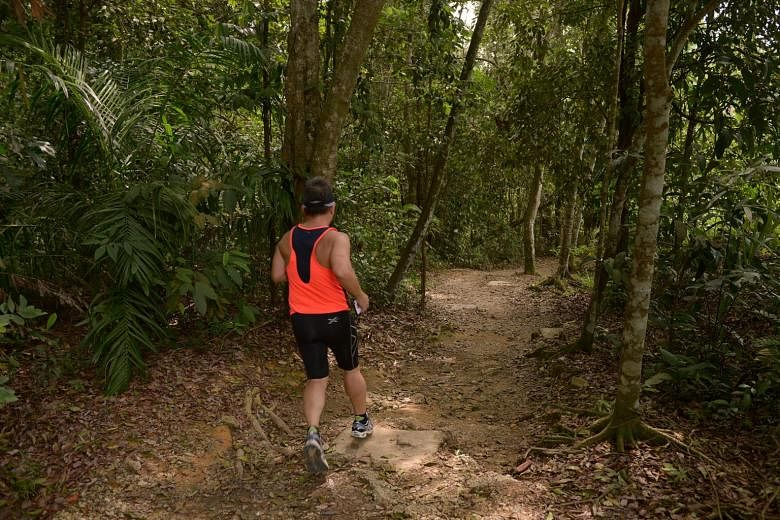The Straits Times Virtual Run (STVR) may be ending on Thursday (Dec 17) but for some of you, this could be the beginning of a healthy habit. STVR and New Balance Run Club coach Loh Guo Pei hopes to help you during your final lap and beyond by answering three reader questions.
1. I am new to running and aim to take part in a 5km race. Should I focus on building up my stamina or my speed?
There are several schools of thought but my opinion and training method would be a good mixture of endurance and speed training for a 5km race. As a 5km race is an endurance event, it is important to build up your aerobic system by clocking more mileage for a start.
Do not be too eager to focus on speed training too early as it will result in higher chances of injury. Without a good endurance base, muscles may not be built to generate the strength required for speed.
Keep track of your weekly mileage (three to four runs a week) and gradually increase your distance by 5 to 10 per cent in order to minimise the risk of injury. After about four to six weeks of consistent training, it is time to try and incorporate some speed training.
A speed workout can be running interval sets anywhere between 200m and 600m at a pace faster than your usual running pace. Going for a shorter distance of 2-3km at a faster pace would also help.
2. I prefer to run in nature parks. Do you have any advice for running on trails? Do I need to take precautions or invest in trail shoes?
If you are exploring new routes, it would be advisable to run with a buddy or interest group that is experienced as you would want to avoid getting lost. Bring a whistle, phone, water and some dry food in case of emergency. If you plan to head out solo, inform a friend or two on your whereabouts before you embark on the run, and provide an estimated duration and update your friends after completion.
Take note of the duration/distance you require for the trail, as some trails might seem short, however, due to the hilly terrain you may take two to three times longer to complete the same distance as compared to running on flat ground.
Bring along a small bottle for hydration or energy gels/bars to fuel you up. Negotiating through the rough terrain may drain you out faster than you think. You can use a small waist pouch to house the gels and bars and carry a hydration bag to stay comfortable.
Choose an easier terrain first, so you can be more agile and adapt to the surroundings.
Lastly, running on trails often involves rapid changes in direction and uneven terrain which require a lot of focus and a good core to maintain balance.
I would recommend any runner to invest in a good pair of trail running shoes in order to protect your feet and prevent any potential injuries from the uneven terrain. An example of a good pair is the New Balance Fresh Foam Hierro V5.
When getting trail shoes, it is recommended to allow more allowance for the toe box room as compared to normal running shoes. It is especially important when you are going downhill as you would want to avoid getting your toes bruised. Try the shoes to get a first-hand experience and understand the differences between running shoes and trail shoes.
3. What should I do when I hit the wall on a long run?
Hitting the wall often refers to the depletion of the stored glycogen (carbohydrate that is stored in our muscles and liver for energy) and it feels like your body is shutting down.
Some things you can do when you hit the wall are:
- Slow down and adjust your pace. Do a walk/jog strategy, take a short walk break between 45 and 90 seconds for every 1km that you have ran.
- Fuel your body with sports drinks or gummies.
Here are some suggestions to reduce the chances of "hitting the wall" on marathon race day.
Training preparation
Slowly increase mileage (a 5-10 per cent increment weekly) for long runs to allow your body to adapt to training stimulus. You may plan a few short runs during weekdays and a long run at the weekend. Gradually overload your body with a little stressor such as longer distance or faster speed for the shorter runs and allow your body to adapt before repeating the process. Don't forget to include rest days.
Nutrition strategy
Carbo loading is to ensure sufficient glycogen storage before your race, and it usually happens two to three days before your marathon race day. However, it is just as important to ensure you are properly fuelled up before your long runs if you are planning to clock a long run of between 28km and 32km that is close to your race pace. In order to ensure adequate energy, it is helpful to consume some sweets or gels/bars during the run.
Hydration strategy
Consistently hydrate during your run with sports drinks every 30 minutes or so in order to prevent dehydration.
Pacing your runs
Avoid surges during your long runs as sudden increases in pace will increase the rate of glycogen being utilised. Also avoid going too fast at the start of the run even when you feel good.
Burning fat for fuel
Apart from speed training and clocking mileage, it is important to train your body to be more efficient in burning fat for fuel during your easy runs. Include long, slow recovery runs in your programme - exercising at long duration and low intensity promotes fat burning. Alternatively, complete your long runs before breakfast, as with lesser glycogen stored in the body when you wake up, your body will turn to burning the stored fat for fuel.

